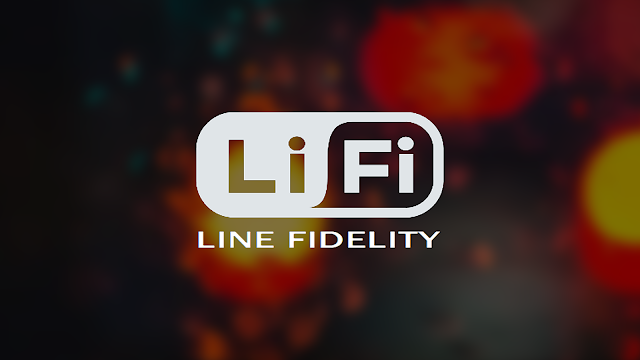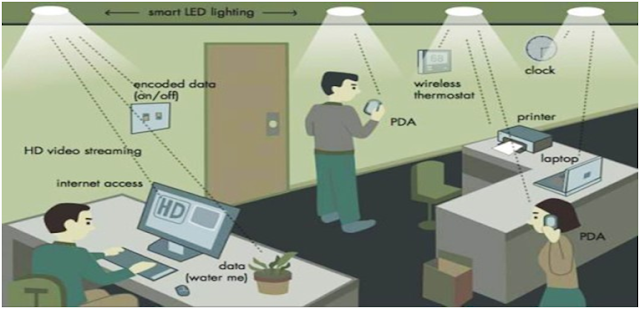What is Li-Fi?
The term Li-Fi was coined by pure LiFi’s CSO, Professor Harald Haas, and refers to light based communications technology that delivers a high-speed, bidirectional networked, mobile communications in a similar manner as Wi-Fi. Although Li-Fi can be used to off-load data from existing Wi-Fi networks, implementations may be used to provide capacity for the greater down link demand such that existing wireless or wired network infrastructure may be used in a complementary fashion.
Light Fidelity (Li-Fi) is a bidirectional, high speed and fully networked wireless communication technology similar to Wi-Fi. The term was coined by Harald Haas and is a form of visible light communication and a subset of optical wireless communications (OWC) and could be a complement to RF communication (Wi-Fi or Cellular network), or even a replacement in contexts of data broadcasting. It is so far measured to be about 100 times faster than some Wi-Fi implementations, reaching speeds of 224 gigabits per second.
It is wireless and uses visible light communication or infra-red and near ultraviolet (instead of radio frequency waves) spectrum, part of optical wireless communications technology, which carries much more information, and has been proposed as a solution to the RF-bandwidth limitations.
Technology Details
This OWC technology uses light from light-emitting diodes (LEDs) as a medium to deliver networked, mobile, high-speed communication in a similar manner to Wi-Fi.The Li-Fi market is projected to have a compound annual growth rate of 82% from 2013 to 2018 and to be worth over $6 billion per year by 2018.
Visible light communications (VLC) works by switching the current to the LEDs off and on at a very high rate, too quick to be noticed by the human eye. Although Li-Fi LEDs would have to be kept on to transmit data, they could be dimmed to below human visibility while still emitting enough light to carry data.The light waves cannot penetrate walls which makes a much shorter range, though more secure from hacking, relative to Wi-Fi. Direct line of sight is not necessary for Li-Fi to transmit a signal; light reflected off the walls can achieve 70 Mbit/s.
Li-Fi has the advantage of being useful in electromagnetic sensitive areas such as in aircraft cabins, hospitals and nuclear power plants without causing electromagnetic interference.Both Wi-Fi and Li-Fi transmit data over the electromagnetic spectrum, but whereas Wi-Fi utilizes radio waves, Li-Fi uses visible light. While the US Federal Communications Commission has warned of a potential spectrum crisis because Wi-Fi is close to full capacity, Li-Fi has almost no limitations on capacity. The visible light spectrum is 10,000 times larger than the entire radio frequency spectrum. Researchers have reached data rates of over 10 Gbit/s, which is much faster than typical fast broadband in 2013. Li-Fi is expected to be ten times cheaper than Wi-Fi.Short range, low reliability and high installation costs are the potential downsides.
PureLiFi demonstrated the first commercially available Li-Fi system, the Li-1st, at the 2014 Mobile World Congress in Barcelona.
Bg-Fi is a Li-Fi system consisting of an application for a mobile device, and a simple consumer product, like an IoT (Internet of Things) device, with color sensor, microcontroller, and embedded software. Light from the mobile device display communicates to the color sensor on the consumer product, which converts the light into digital information. Light emitting diodes enable the consumer product to communicate synchronously with the mobile device.
LiFi is a disruptive technology which will shift business models and create opportunities ripe for exploitation. The dominance and lifetime of LED lighting has created a need for new business models in the lighting industry. The need to offer services, including new payment and financing models, creates an unprecedented opportunity for LiFi.
The need for more capacity for mobile communications has an incredible impact on the need for more spectrum. Specifically, the pending decision on the auction surrounding the 700MHz part of the spectrum in the UK and the possibility of regulation of the unlicensed spectrum, where Wi-Fi and Bluetooth thrive, provide key indicators as to the urgency of the problem. LiFi operates in the unlicensed and safe visible light spectrum where the spacial reuse of bandwidth results in dramatic increases in the overall capacity of a wireless solution.
At pureLiFi, the home of LiFi, we aim to address and optimally exploit the opportunities presented by this disruptive technology in conjunction with our LiFi ecosystem partners.
Li-Fi- XLiFi-X – The fastest, smallest and most secure LiFi system
The LiFi-X will be publicly demonstrated at Mobile World Congress in Barcelona on 22 – 25 February at the Scottish Development International stand (Hall 7, Stand 7B31).
The LiFi-X is the evolution of the world’s first LiFi system, the Li-Flame. The system offers partners the ability to deploy a fully networked LiFi solution. Unlike existing VLC products, the LiFi-X supports multiple access, roaming, complete mobility and ease of use – providing a level of user experience that is comparable and more secure than existing wireless technologies such as Wi-Fi.
The LiFi-X delivers high data densities and eliminates unwanted external network intrusion. In addition, the merger of illumination with wireless communications provides a measurable reduction in both infrastructure complexity and energy consumption. LiFi-X delivers:
- Full duplex communication with a 40Mbps downlink and 40Mbps uplink;
- Full mobility (portable, USB-powered station)
- Multiple users per LiFi Access Point, supported through multiple access
- Secure wireless communications constrained by walls, eliminating the risk of signal leakage to external eavesdroppers
- Safe wireless communication in environments where radio frequencies are not suitable
- Flexible deployments
- Extensive range of wireless communication applications including and beyond existing Wi-Fi
- A cost-effective delivery of light and data via a single infrastructure
LiFi-X Access Point (AP)
- Support for Power over Ethernet (PoE) or Power Line Communications (PLC)
- Simple installation
- Connect to a wide range of LED light fixture to form an atto-cell
- Multiple access
- Handover control enables seamless switching between APs
LiFi-X Station (STA)
- USB 2.0 powered
- Supports handover, allowing user to move maintain their wireless session
Source: Wikipedia and PureLifi.com











